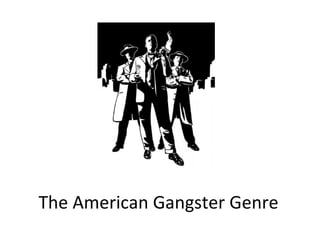The American Gangster Genre
•Als PPT, PDF herunterladen•
1 gefällt mir•2,552 views
Melden
Teilen
Melden
Teilen

Weitere ähnliche Inhalte
Was ist angesagt?
Was ist angesagt? (20)
Ähnlich wie The American Gangster Genre
Ähnlich wie The American Gangster Genre (20)
ENG 239 Review for Exam 3The exam will cover the following.docx

ENG 239 Review for Exam 3The exam will cover the following.docx
Mehr von mjarry
Mehr von mjarry (20)
Kürzlich hochgeladen
Call Girls New Ashok Nagar Delhi WhatsApp Number 9711199171

Call Girls New Ashok Nagar Delhi WhatsApp Number 9711199171Delhi Call Girls 📞9899900591 ✔️ High Profile Service 100% Safe
Call Girl Nashik Amaira 7001305949 Independent Escort Service Nashik

Call Girl Nashik Amaira 7001305949 Independent Escort Service NashikCall Girls in Nagpur High Profile
Desi Bhabhi Call Girls In Goa 💃 730 02 72 001💃desi Bhabhi Escort Goa

Desi Bhabhi Call Girls In Goa 💃 730 02 72 001💃desi Bhabhi Escort Goarussian goa call girl and escorts service
Kürzlich hochgeladen (20)
Independent Hatiara Escorts ✔ 8250192130 ✔ Full Night With Room Online Bookin...

Independent Hatiara Escorts ✔ 8250192130 ✔ Full Night With Room Online Bookin...
Goa Call "Girls Service 9316020077 Call "Girls in Goa

Goa Call "Girls Service 9316020077 Call "Girls in Goa
Call Girls Service Bantala - Call 8250192130 Rs-3500 with A/C Room Cash on De...

Call Girls Service Bantala - Call 8250192130 Rs-3500 with A/C Room Cash on De...
Russian Escorts Agency In Goa 💚 9316020077 💚 Russian Call Girl Goa

Russian Escorts Agency In Goa 💚 9316020077 💚 Russian Call Girl Goa
Call Girls New Ashok Nagar Delhi WhatsApp Number 9711199171

Call Girls New Ashok Nagar Delhi WhatsApp Number 9711199171
↑Top Model (Kolkata) Call Girls Howrah ⟟ 8250192130 ⟟ High Class Call Girl In...

↑Top Model (Kolkata) Call Girls Howrah ⟟ 8250192130 ⟟ High Class Call Girl In...
Call Girls Manjri Call Me 7737669865 Budget Friendly No Advance Booking

Call Girls Manjri Call Me 7737669865 Budget Friendly No Advance Booking
Book Call Girls in Panchpota - 8250192130 | 24x7 Service Available Near Me

Book Call Girls in Panchpota - 8250192130 | 24x7 Service Available Near Me
Call Girl Nashik Amaira 7001305949 Independent Escort Service Nashik

Call Girl Nashik Amaira 7001305949 Independent Escort Service Nashik
Karnal Call Girls 8860008073 Dyal Singh Colony Call Girls Service in Karnal E...

Karnal Call Girls 8860008073 Dyal Singh Colony Call Girls Service in Karnal E...
↑Top Model (Kolkata) Call Girls Salt Lake ⟟ 8250192130 ⟟ High Class Call Girl...

↑Top Model (Kolkata) Call Girls Salt Lake ⟟ 8250192130 ⟟ High Class Call Girl...
Call Girl Nagpur Roshni Call 7001035870 Meet With Nagpur Escorts

Call Girl Nagpur Roshni Call 7001035870 Meet With Nagpur Escorts
VIP Call Girls Sonagachi - 8250192130 Escorts Service 50% Off with Cash ON De...

VIP Call Girls Sonagachi - 8250192130 Escorts Service 50% Off with Cash ON De...
Dakshineswar Call Girls ✔ 8005736733 ✔ Hot Model With Sexy Bhabi Ready For Se...

Dakshineswar Call Girls ✔ 8005736733 ✔ Hot Model With Sexy Bhabi Ready For Se...
Desi Bhabhi Call Girls In Goa 💃 730 02 72 001💃desi Bhabhi Escort Goa

Desi Bhabhi Call Girls In Goa 💃 730 02 72 001💃desi Bhabhi Escort Goa
👙 Kolkata Call Girls Shyam Bazar 💫💫7001035870 Model escorts Service

👙 Kolkata Call Girls Shyam Bazar 💫💫7001035870 Model escorts Service
↑Top Model (Kolkata) Call Girls Behala ⟟ 8250192130 ⟟ High Class Call Girl In...

↑Top Model (Kolkata) Call Girls Behala ⟟ 8250192130 ⟟ High Class Call Girl In...
𓀤Call On 6297143586 𓀤 Ultadanga Call Girls In All Kolkata 24/7 Provide Call W...

𓀤Call On 6297143586 𓀤 Ultadanga Call Girls In All Kolkata 24/7 Provide Call W...
Book Paid Sonagachi Call Girls Kolkata 𖠋 8250192130 𖠋Low Budget Full Independ...

Book Paid Sonagachi Call Girls Kolkata 𖠋 8250192130 𖠋Low Budget Full Independ...
The American Gangster Genre
- 1. The American Gangster Genre